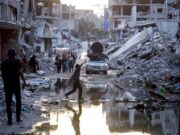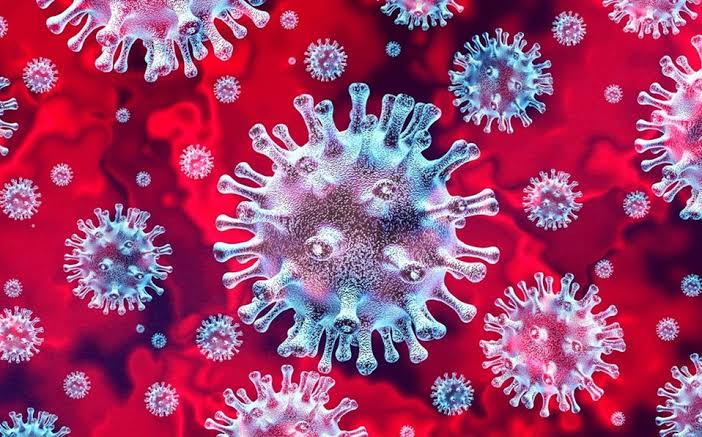The coronavirus will likely spread for the next 18-24 months and infect up to 70% of the population, several pandemic experts said in a new report.
Even in a “best-case scenario,” people will continue to die, and ongoing infections will occur throughout this year and next year, according to the report released Thursday.
“This thing’s not going to stop until it infects 60 to 70 percent of people,” Mike Osterholm, director of the Center for Infectious Disease Research and Policy (CIDRAP) at the University of Minnesota, told CNN. “The idea that this is going to be done soon defies microbiology.”
Osterholm, who has advised several presidents on pandemics during the past 2 decades, co-authored the nine-page report, titled “COVID-19: The CIDRAP Viewpoint,” with epidemiologists from the Harvard School of Public Health and formerly from the CDC.
The team used prediction models, historic pandemic data, and published reports about COVID-19 to forecast the next 2 years. Based on that, they said government officials should prepare for a long-term pandemic. They discussed three scenarios:
The first scenario could be that the first wave of COVID-19 this spring is followed by several smaller waves during the summer and the next 2 years, gradually decreasing throughout 2021. This could vary by geography and require periodic shelter-in-place recommendations.
The second scenario could be that the first wave is followed by a larger wave in the fall or winter, and then smaller waves in the 2021, which could require shelter-in-place measures again in the fall. This scenario mimics the 1918-1919 pandemic.
The third scenario could be a “slow burn” of transmission during the next 2 years, which may not require additional shelter-in-place orders but will continue to cause new cases and deaths.
To prepare, states should plan for the second scenario, or the “worst-case scenario,” they wrote, especially since the coronavirus has a long incubation period and is spread easily by people without symptoms. A vaccine could help, of course, but a widespread vaccine may not be likely until 2021, they added.
The report is focused on the Northern Hemisphere. But the pandemic could be even harsher in developing countries in the Southern Hemisphere that lack health care infrastructure and have a high number of infections and illnesses that make COVID-19 symptoms more severe, according to the report.
“Government officials should develop concrete plans, including triggers for reinstituting mitigation measures, for dealing with disease peaks when they occur,” the authors wrote.
“Risk communication messaging from government officials should incorporate the concept that this pandemic will not be over soon and that people need to be prepared for possible periodic resurgences of disease over the next two years,” they said.
University of Oxford Starts Human Clinical Trials for Vaccine
May 1, 12:08 p.m.
Researchers at the University of Oxford have started clinical trials with humans for a coronavirus vaccine and might have results in a couple of months, the university said in a news release.
The school said around 1,110 people who have not tested positive for COVID-19 will take part, with half receiving the vaccine and the other half — the control group — receiving a meningitis vaccine. They will keep a diary and have blood samples taken to show how they’re responding to the vaccine.
To see if the vaccine works, infection rates in the two groups will be compared. A number of participants will need to develop COVID-19, the release said.
“If transmission remains high, we may get enough data in a couple of months to see if the vaccine works, but if transmission levels drop, this could take up to 6 months,” the release said.
Oxford professor John Bell told the BBC that researchers “hope to get some signal about whether it’s working by the middle of June.”
Drug manufacturer AstraZeneca has agreed to distribute the vaccine if it works, the company said in a news release.
U.S. Must Face COVID-19 Vaccine Challenges, Experts Say
Besides coming up with a coronavirus vaccine, the United States must also figure out the best, fastest way to manufacture and deliver a vaccine to the populace, two experts said Friday morning during an Infectious Diseases Society of America media briefing.
“Vaccines don’t save lives. Vaccinations save lives,” said Walter A. Orenstein, MD, a professor in the division of infectious diseases at the Emory University School of Medicine in Atlanta. “When first licensed, we won’t have 7 billion doses the next day to vaccinate the whole world.”
Orenstein said the government should “incentivize” manufacturers to start making vaccines while a vaccine is still going through clinical trials, so that the vaccine could be quickly put into use after approval. But if the vaccine fails the trials, the product would have to be destroyed, he said.
“We need to be thinking about those issues now,” Orenstein said.
Another challenge is figuring out who gets the vaccine first.
The CDC’s Advisory Committee on Immunization Practices will decide that, he said, but he thought that essential workers, people suffering the most like the elderly, and people identified as “transmitters” would most likely be at the top of the list.
Kathryn M. Edwards, MD, the scientific director at the Vanderbilt Vaccine Research Program in Nashville, said the United States already has a system in place to deliver vaccinations to children that could help develop a system for the coronavirus. The U.S. also has experience providing vaccines for the Ebola pandemic in West Africa, she noted.
She said another question that must be addressed is whether the coronavirus vaccine will be a one-time event for a person, or whether the virus is mutating and will require follow-up shots with different vaccines.
At all times in the development process, safety must be emphasized, Edwards said. “We want the vaccine, but we want a safe vaccine,” she said.
Edwards and Orenstein said one of the bright spots in developing the vaccine is that a lot of testing is underway. Orenstein said the World Health Organization reported eight vaccines are now in clinical trials, and 94 are in pre-clinical trials.
Federal Government to Increase PPE Shipments to Nursing Homes
The federal government will increase inspections and shipments of equipment to nursing homes, which have been hotbeds of coronavirus cases, according to a news release on the White House website.
The Federal Emergency Management Agency (FEMA) will start sending supplemental shipments of personal protective equipment to all 15,400 Medicaid- and Medicare-certified nursing homes in the United States, the release said, and the Centers for Medicare & Medicaid Services will provide $81 million to the states to increase inspections.
A new rule being put in place will require nursing homes to report information about COVID-19 cases directly to the CDC, the release said. Nursing homes will also have to report cases to family members.
The administration will set up a Coronavirus Commission for Safety and Quality in Nursing Homes made up of industry experts, doctors, scientists, and patient advocates.
NYC to Stop Subway Service 4 Hours Daily to Disinfect Trains
New York City will shut down subway service from 1 to 5 a.m. starting May 6 so trains and stations can be disinfected, the Metropolitan Transportation Authority said Thursday on its website.
The city is the epicenter of the U.S. coronavirus pandemic, with at least 12,571 confirmed deaths and 5,295 probable deaths, according to the city website.
The MTA said it has launched a free “essential connector” service to transport essential workers, such as health care workers and first responders, during those 4 hours of cleaning.
“Essential Connector riders will be limited to two trips per night on for-hire-vehicles and must show proof of essential travel with appropriate credentials. Riders who do not have a smartphone will be able to request a ride through a dedicated number,” the MTA said.
MTA bus service will continue to operate 24/7.
“It is a massive undertaking that we have never done before,” New York Gov. Andrew Cuomo said at a news conference, according to NY1.
TSA: 500 Employees Test Positive for COVID-19
More than 500 Transportation Security Administration employees have tested positive for the coronavirus, according to the agency’s COVID-19 data page.
As of Thursday morning, the page said 505 employees had tested positive, and among those, 212 had recovered and five had died.
In a chart, the TSA also lists the confirmed cases at each airport, which is split between the number of TSA screening officers and non-screening employees. The list includes the last work date of the most recent screening officer who tested positive. The list doesn’t include non-airport TSA employees or contractors who have limited interaction with the public.
“Passengers who believe they may have come in contact with an infected individual within the past 14 days should follow the CDC’s recommendations for travel-associated exposure,” according to the TSA website.
According to the chart, positive cases were largest in major cities. About 40% were in the three major airports that serve the New York City area. John F. Kennedy International Airport has 105 employees who tested positive, LaGuardia Airport has 32 employees who tested positive, and Newark Liberty International Airport has 56 employees who tested positive.
Here are other major airports and their total confirmed cases:
Louis Armstrong New Orleans International Airport: 27
Miami International Airport: 18
Denver International Airport: 17
Logan International Airport in Boston: 16
Fort Lauderdale-Hollywood International Airport in Florida: 16
Chicago O’Hare International Airport: 14
Hartsfield-Jackson Atlanta International Airport: 14
Orlando International Airport: 14
Dallas/Fort Worth International Airport: 13
Los Angeles International Airport: 11
On Wednesday, TSA issued a statement after Mark Barisonek, a TSA officer at the Newark Liberty International Airport, died from COVID-19 on Tuesday.
“For nearly 16 years, Mark dedicated his career to the TSA mission. He was an integral member of Team Newark and will be remembered fondly by those who knew him and worked alongside him,” according to the statement.
Barisonek is the second TSA member at the Newark airport to die from COVID-19. Francis “Frank” Boccabella III, an explosive detection canine handler, died on April 2. Boccabella was the first TSA employee to die from COVID-19.
CDC: Most Hospitalized COVID-19 Patients in Georgia Are Black
April 30, 1:02 p.m.
More than 80% of patients hospitalized for the coronavirus in Georgia in March were African Americans, according to a new CDC studyreleased Wednesday.
The CDC, headquartered in Atlanta, surveyed eight hospitals across the state, including seven in the metro Atlanta area and one in southern Georgia.
Among the 305 COVID-19 patients, 247 — more than 80% — were black. Thirty-two patients were white, 10 were Hispanic, and eight were Asian or Pacific Islander.
“The proportion of hospitalized patients who were black was higher than expected based on overall hospital admissions,” the study authors wrote.
Black patients weren’t more likely to require a ventilator or die during hospitalization, according to the study. They also weren’t more likely to have diabetes or heart disease, which could affect the severity of COVID-19, though about 74% of patients overall had conditions considered high-risk for severe COVID-19. Diabetes was most common in patients between ages 50 and 64.
“Given the overrepresentation of black patients within this hospitalized cohort, it is important for public health officials to ensure that prevention activities prioritize communities and racial/ethnic groups most affected by COVID-19,” the study authors wrote.
About 36% of COVID-19 cases in Georgia are in African American people, according to the state’s public health department, which is a little higher than the state population of 32%.
Similar trends have been documented in other states, according to CBS. In Maryland, black people make up 31% of the population and 45% of coronavirus deaths. In Louisiana, black people make up 33% of the population and 56% of coronavirus deaths.
Major cities such as New York, Detroit, and Washington, D.C., have also reported racial disparities in COVID-19 cases, CBS said.
Los Angeles Offers Free COVID-19 Tests for All Residents
All residents in Los Angeles County should be able to receive a coronavirus test, whether or not they have COVID-19 symptoms, Los Angeles Mayor Eric Garcetti announced Wednesday evening.
Testing is by appointment only at coronavirus.lacity.org/testing, and tests are available at eight places in the city of Los Angeles, according to the announcement.
The website has links to schedule an appointment, find a nearby testing location, and read frequently asked questions. It also has information about testing for front-line health care workers, skilled nursing facilities, and Kaiser Permanente members. Residents can also watch a test preparation video and learn about test results.
Priority for same- or next-day testing will still be given to people with symptoms such as a fever, coughing, and shortness of breath, the site says, and residents must indicate their symptoms when scheduling a test.
People who have severe symptoms such as extreme shortness of breath should still contact a doctor or call 911.
The testing program began about a month ago with one location staffed by the Los Angeles Fire Department and has grown to eight sites inside the city and 34 sites across the region, according to the announcement. The program has completed 140,000 tests since March 20.
The program is a partnership among the city of Los Angeles, the county of Los Angeles, and the Community Organized Relief Effort, or CORE.
The announcement came the same day county health officials reported a surge in new COVID-19 cases, according to NPR, which they attributed to more widespread testing.
The Los Angeles County Health Department reported more than 1,500 new cases, which is the largest single-day increase since the start of the pandemic. At the same time, hospitalizations and deaths have remained steady, health officials said.
How many people have been diagnosed with the virus, and how many have died?
According to Johns Hopkins University, there are more than 3.32 million cases and more than 237,000 deaths worldwide. Over 1.04 million people have recovered.
How many cases of COVID-19 are in the United States?
There are more than 1.09 million cases in the U.S. of COVID-19, and over 64,000 deaths. More than 159,000 Americans have recovered from the disease, according to data compiled by Johns Hopkins University. See a map of cases and deaths by state here.
What travel restrictions are there?
The State Department has urged all U.S. citizens to avoid any international travel due to the global impact of the new coronavirus.
If you are currently overseas, the department wants you to come home, “unless [you] are prepared to remain abroad for an indefinite period,” according to a statement.
“Many countries are experiencing COVID-19 outbreaks and implementing travel restrictions and mandatory quarantines, closing borders and prohibiting non-citizens from entry with little advance notice,” the agency says.
In addition, the State Department says it will not issue any new passports except for people with a “qualified life-or-death emergency and who need a passport for immediate international travel within 72 hours.” The U.S. is banning all foreign travel to the United States from most of Europe for 30 days beginning midnight Friday, March 13. American citizens are not included in the ban.
The U.S. has also temporarily suspended nonessential travel to Mexico and Canada.
Kathleen Doheny, Ralph Ellis, Jonathan Mintz, Carolyn Crist and HealthDay News contributed to this report.






























